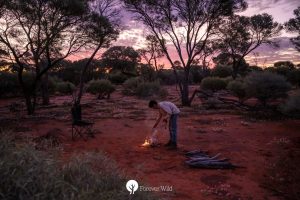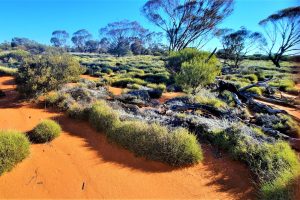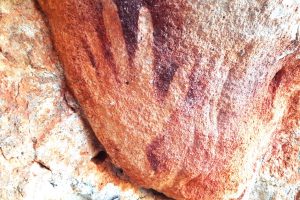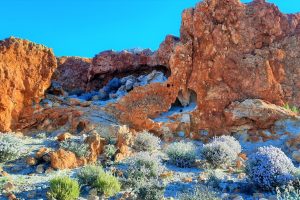Narndee lies adjacent to Boodanoo, and together they make up a wilderness area of just over 2,225 square kilometres in the southern part of Western Australia.
This landscape was first identified by Forever Wild in 2018, as a place rich in biodiversity, cultural heritage, and vast, awe-inspiring wilderness landscapes. Incredibly, this part of the world has long been overlooked by conservation organisations and cultural heritage funding entities.
These are places where venturing off the road requires careful preparation, and where our staff carry plenty of water and satellite communications at all times. There are few fences, and the emus and red kangaroos can move freely across thousands of square kilometres on Narndee, Boodanoo and adjacent reserves.
Narndee is home to Mallee Fowl, a threatened and very unique species, and we expect that in time new and exciting species will be discovered.
Wilderness Values
Vast and isolated, Narndee is an inspiring landscape that humbles the soul! Red 'breakaway' country (small cliffs with crumbling soft rock underneath) hold multiple rock art sites in small caves, and standing atop the cliffs in some places, the mulga woodlands stretch unbroken to the horizon.
Human Spirit
Narndee has a rich history of Indigenous and early settler history. Right up to the 1980's some of the Traditional Owners lived and worked on Narndee, and in time we hope to encourage them to share their history, perspectives and ideas for management. Narndee also holds an important heritage site called Dromedary Hills, or Camel Camp, and a homestead with some original stone buildings.
Biodiversity
After good winter rains, which only occur every few years, the wildlife on Narndee is abundant. The mulga woodlands and saltbush plains host flocks of thousands of budgerigars, and Mulga and Burke's parrots streak through the trees in pairs or small flocks.
The mulga woodlands share the soil with millions of desert wildflowers. The mulga trees themselves are fascinating simply due to their extraordinary adaptations. A true semi-arid plant, part of the acacia family, their roots can tap into water deep beneath the surface. They can live for an astonishing 300 years, and even the dead timber can stand for decades, hardened and cracked by the elements. These cracked, dead trees are home to many small reptiles and invertebrates.
When the winter rains have passed and the daytime temperatures climb towards 50 degrees celsius, the surface water disappears, along with the swirling flocks of budgerigars. Only the hardiest creatures remain, scurrying in and around their ancient mulga homes.
Wilderness Economies
Narndee is central to Forever Wild's low-impact agriculture program. At Forever Wild, we focus on creating balance between people and nature, to create very long-term outcomes where nature can be protected alongside livelihoods and sustainable economics. This work is urgent and essential if we are to effectively compete with destructive and exploitative economic practices, and move towards restorative economics where decisions revolve around nature and our cultural heritage.






